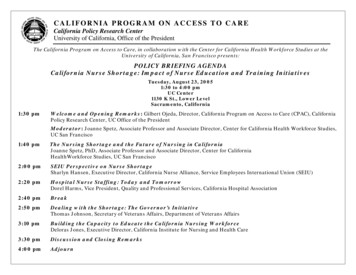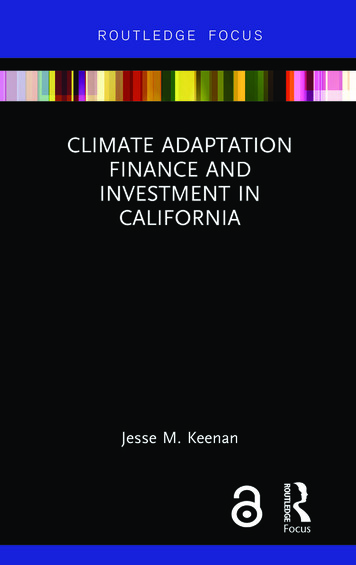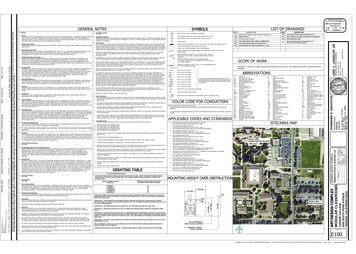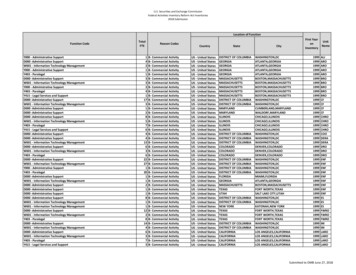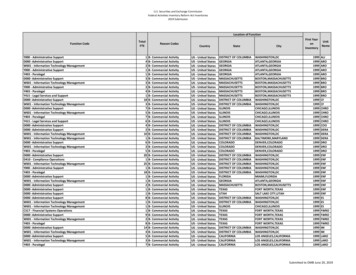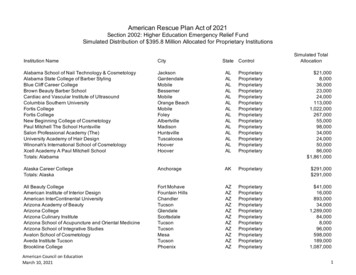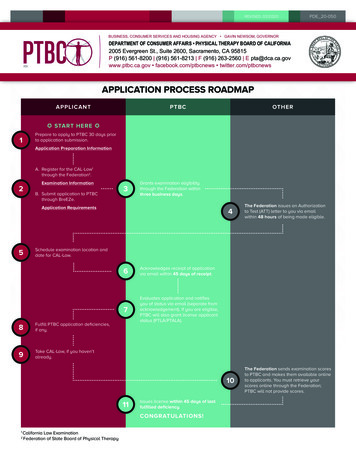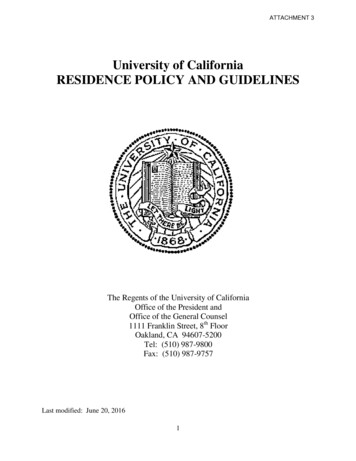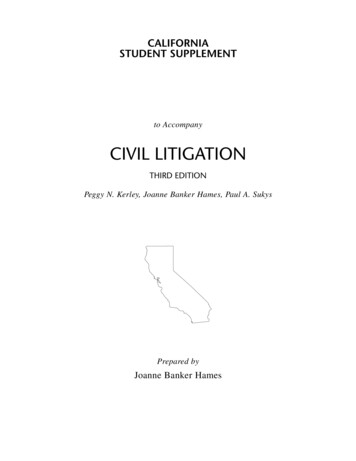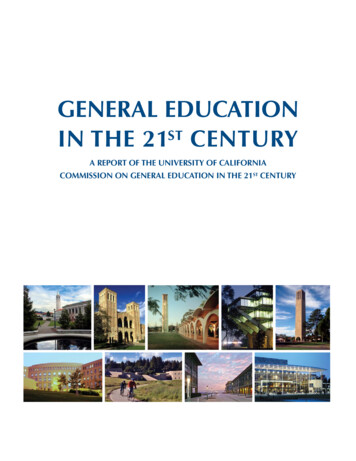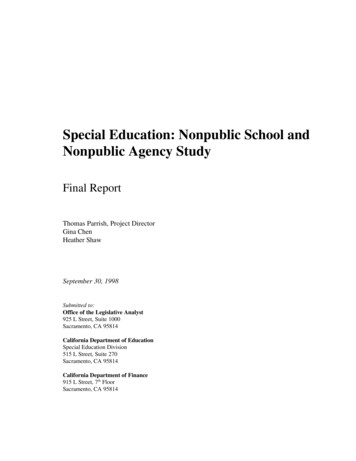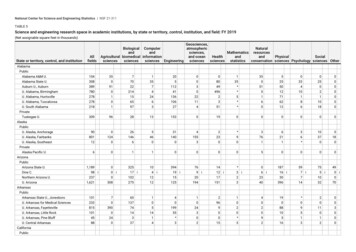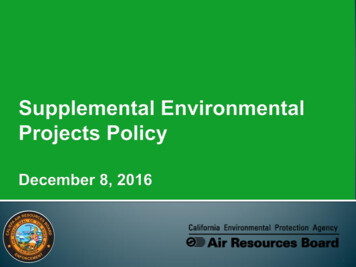
Transcription
1
Introduction Current Supplemental EnvironmentalProjects Community EngagementProposed Policy and ProcessSummary of CommentsSummary and Next Steps2
FieldEnforcementandInvestigationNotice ofViolationResolve ViolationThrough MutualSettlementProcessSelect SEP Goal: Compliance Most violations resolved by mutual settlementCompliance Penalties Supplemental Environmental Projects 3
SEP defined in Public Resources Code§71118 Environmentally beneficial project Violator “voluntarily agrees to undertake insettlement of the action and to offset a portion ofa civil penalty.”4
Year20142015Total CivilPenalties Assessed Allocated to SEPs 13,372,941 2,308,566 10,397,660 1,633,9005
Solicit SEPs from disadvantagedcommunities through a public process Allow SEP to offset up to 50% of the penaltyProvide a list of SEPs to CalEPA annuallyConsider nexus to location of violationFocus on projects in disadvantagedcommunities6
Obtain Board’s input and direction Proposed SEP Policy SEP Selection Criteria Preference Criteria SEP Project Types7
Introduction Current Supplemental EnvironmentalProjects Community EngagementProposed Policy and ProcessSummary of CommentsSummary and Next Steps8
California Council on Diesel Education andTechnology (CCDET) School Bus and Diesel Emission Reduction Foundation for California CommunityColleges Small Engine Maintenance andRepair Courses SEP9
Consortium of six community collegesTrains next generation of diesel mechanics 456,400 was allocated to 6 colleges in 2015Funding allows colleges to purchase trucks andengines necessary to teach diesel classesCCDET alsoCertifies opacity testers for ARB regulations Trains violators to comply with opacity regulations Conducts special projects 10
Established in 2011 to fund replacementfilter cores for recalled Cleaire retrofit PMfilters Provides funding for truck and bus projectsthat exceed regulatory requirements 1,147,500 in SEP funds generated in 201511
Established in 2014 Enhances and improves small enginemaintenance/repair courses at 3 Californiacommunity colleges 30,000 SEP funds generated in 201512
Introduction Current Supplemental EnvironmentalProjects Community EngagementProposed Policy and ProcessSummary of CommentsSummary and Next Steps13
Staff attend monthly Environmental JusticeTask Force meetings in: Bayview / Hunters Point, Hanford, Fresno,Bakersfield, Los Angeles, Coachella, and BrawleyTwo series of SEP Workshops Nine in August and September Fresno, Hanford, Oakland, Bakersfield, El Monte, CoachellaValley, Brawley, Mecca Five in October Fresno, Oakland, Bakersfield, El Monte, Brawley14
Introduction Current Supplemental EnvironmentalProjects Community EngagementProposed Policy and ProcessSummary of CommentsSummary and Next Steps15
Five key elements of the SEP Policy Public process to identify SEP proposals Provide our SEP Eligibility List to CalEPAannually Defines SEP selection and preference criteria SEP Categories Three ways a SEP can be funded16
SEPs must meet all of the following criteria: Furthers ARBs purpose by: Reducing the risk burden posed to public health Preventing future air quality problems, or Improving the injured environment Has a nexus to the violation either through locationor pollutant Detailed project proposal to include a scope of work,budget, timeline, and recipient qualifications Does not benefit the violator Goes above and beyond regulatory requirements17
Nexus is the relationship between theviolation and the proposed project A project has a relationship to the violationeither through location or pollutant(s) Projects funded through case settlement willbe matched by location and/or pollutant(s)18
ARB prefers SEPs meeting one or more ofthese additional criteria: Provide direct emissions or exposure reductions Benefit disadvantaged communities Provide community benefits Provide multimedia (e.g. air, water, soil) benefits19
SEP Proposals require documentationincluding:Organization description & experience Project description & timeline Itemized budget Emissions benefit description SEP Proposals will also be accepted on acontinual basis20
Received 14 SEP ProposalsExposure reduction Education and outreach Air monitoring Tree planting and community improvements Health care support Currently evaluating SEP proposals fornexus and feasibility21
Present SEPs toviolator afterpenalties areagreed uponViolator selects SEPfrom List and FundDirectlyViolator pays SEPAdministrator andAdministratorImplements SEPViolator develops aSEP and FundDirectly22
Violator can fully fund a SEP Pays SEP money directly to the SEP recipient Recipient is responsible for oversight, trackingand reporting to ARB.Violator selects a SEP from the Eligibility Listestablished by ARBRecipient is liable and responsible to ensurecompletion of the SEP23
Violator deposits SEP money into a SEP Administrator’s accountAdministrator disburses the funds to therecipientAdministrator is responsible for oversight,tracking and reporting to ARBRecipient is responsible for ensuring projectcompletion24
Violator designs and implements a SEPthemselves Violator is responsible for ensuring SEPcompletion Violator is responsible for oversight, trackingand reporting to ARB.25
Introduction Current Supplemental EnvironmentalProjects Community EngagementProposed Policy and ProcessSummary of CommentsSummary and Next Steps26
Priority should be given to projects that:Have a strong nexus to location Include community involvement Tie into existing programs Have multimedia benefits and multiagencysupport Assemble an advisory panel Violators should not play a role in projectselection27
Introduction Current Supplemental EnvironmentalProjects Community EngagementProposed Policy and ProcessSummary of CommentsSummary and Next Steps28
Proposed policy meets AB1071requirements Seeking Board support to:Finalize and implement the policy Provide a project list to CalEPA Fund new SEPs Annually update the Board on the implementationof the SEP program 29
Enhances and improves small engine maintenance/repair co
